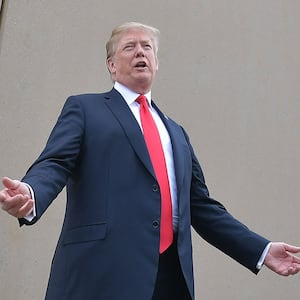Although President Trump has threatened for weeks to declare a national emergency to build a border wall, his announcement of that emergency on Friday exposed a lack of even basic planning for an act that crosses a constitutional Rubicon.
Officials at the major U.S. agencies that will implement the declaration were unable to identify how it will operate in practice. Legislators overseeing those agencies said they had been told nothing. And legal observers were stunned that Trump himself made an admission likely to set the federal courts on a path to reckoning with their credibility—if not the integrity of the constitutional system itself.
“I didn’t need to do this, but I’d rather do it much faster,” Trump said about a declaration with the potential to redefine the relationship between the presidency and Congress.
ADVERTISEMENT
That admission, said Liza Goitein of the Brennan Center for Justice at New York University Law School, could dramatically complicate the Trump administration’s standing once the emergency declaration ends up in the courts.
“If the courts are being asked to review whether or not there’s a real emergency here, and the president is on record saying, essentially, ‘No,’ that’s pretty significant,” said Goitein. “Even a court inclined to be deferential will have to take note of this admission.”
It’s an open question if the courts will take note of what Trump admitted. The Supreme Court proved last year that just because Trump repeatedly said his so-called travel ban was aimed at keeping Muslims out of the country doesn’t mean a majority of justices will call a presidential order illegally discriminatory.
Judges may think the safest way out of the latest Trump-borne controversy to reach their dockets is to ignore the president’s words and their potential legal ramifications. But Goitein doesn’t believe federal courts can be willfully blind forever. They might avoid the merits of the emergency declaration by examining the narrower question of whether the National Emergencies Act authorizes the particular powers Trump seeks to use for funding the construction of the wall. But doing so creates risks.
“If they find that those powers would authorize building a wall in a true emergency, then they’ll be forced to look at whether the emergency declaration itself is valid,” she said. “How deferential will the courts be? Endlessly deferential? At some point the word ‘emergency’ has to have some meaning. And if so, then it shouldn’t apply here.”
Still, “should” is a slippery word in the Trump era. The post-emergency declaration world on Friday afternoon was defined by nothing so much as uncertainty—including uncertainty in where the president was sourcing his assertions.
In his Rose Garden address, the president said that illegal crossings across an unguarded border were increasing, with coyotes smuggling duct-taped women and girls being sold into sexual slavery, along with massive amounts of fentanyl. But non-government experts in the field told The Daily Beast that the president’s statistics appear to come out of the clear blue sky and government sources refused to provide data that would underpin Trump’s assertions.
“Not even the most conservative organizations on immigration policy have ever come close to calculating an estimate that high and to date the White House has shown no source for their estimates,” said Meg Wiehe, deputy director of the Institute on Taxation and Economic Policy. “All of the research I have seen has clearly shown that the number of undocumented immigrants has been steadily falling each year.”
The president’s own answers on the sources of his data were not illuminating either.
“I get my numbers from a lot of sources, like Homeland Security primarily, and the numbers that I have from Homeland Security are a disaster,” Trump said.
Those sources, according to those who work in the field, are either bad at their math or don’t exist.
“The president has a history of throwing around numbers that even the most extreme hard liners have a hard time defending,” said David Dyssegaard Kallick, director of immigration research at the Fiscal Policy Institute. “Researchers have now had decades—more time than anyone ever imagined—to estimate how many undocumented immigrants there are in the United States. The very broad consensus is that the number today is around 11 million.”
Requests for clarification made to the Department of Homeland Security, whose own reports directly contradict each of the president’s assertions, were not answered. The Department of Justice, which oversees the Drug Enforcement Agency, referred questions to the Department of Homeland Security. And the White House did not return a request for the sources of the president’s statistics.
In a conference call with reporters on Friday morning, acting White House chief of staff Mick Mulvaney identified three “pots” of money from which the administration would draw its border wall funding. About $600 million will come from a Treasury Department asset forfeiture account, he said. Another $6.1 billion will be extracted from Defense Department counternarcotics and military construction programs. Mulvaney declined to specify which specific Pentagon projects might be deprived of funds as a result.
If it sounds like the Pentagon doesn’t know which of its projects are going to lose out to free up billions of dollars to build the wall Trump wants, that’s because it doesn’t.
The Pentagon has said for weeks that it’s been looking at “available authorities and funding mechanisms to identify options to enable border barrier construction,” a statement it re-upped Friday morning. Congressional officials overseeing the Pentagon said they were in the dark as to what construction and other projects—projects with constituencies that may register opposition to the diversion—are on hold or on the block.
By late Friday afternoon, all the Pentagon added was a notification that it had found specific authorities concerning military construction, counter-drug efforts and ready-reserve activation relevant to Trump’s declaration of a national emergency.
And that’s as far as the Pentagon, which is fond of reminding the public of its reputation as a “professional planning organization,” has gotten.
“We have ID’d funding that’s unobligated and available, but it’s not been decided that these specific programs get deferred, canceled or cut to divert money to a border wall,” a defense official told The Daily Beast on Friday night.
The lack of specifics speaks to the uncharted territory that the emergency declaration, a step to circumvent a congressional funding deal that Trump disliked for insufficient wall funding, has guided the administration and the country into. Patrick Shanahan, the acting secretary of defense, was traveling abroad this week. First Shanahan has to affirm implementation of Trump’s decision, and then a process will unfold leading to the acting secretary deciding on what particular projects are paused, cut or axed.
Members of Congress were also waiting for information on what projects would be paused or canceled as the White House redirects $3.6 billion of dedicated military-construction money to the wall. A spokesperson for the House Armed Services Committee said the committee had yet to be provided with any details about the reprogramming.
Rep. John Garamendi (D-CA), the chairman of the HASC subcommittee on readiness, told The Daily Beast that the projects that could be affected stretch from Tyndall Air Force Base in Florida and Marine Corps Base Camp Lejeune in North Carolina—both of which sustained damage during the recent hurricane season—to Travis Air Force Base in California, which was awaiting a new hangar to house the planes that are coming online. Garamendi said removing money from the drug interdiction program was particularly concerning.
“Almost all of the drugs go through the Central American countries now. Pulling money out of that is just the height of, I’ll just say ignorance, to say nothing of hubris,” he said. “If you are building a wall to stop the drug trade, wouldn’t you want to stop it in Colombia and Central America before it ever gets to the shores of America or to the border.”
“What are they thinking?” he said, then quickly concluded, “Well, they’re not.”
Legally, Trump, via Acting Secretary of Defense Patrick Shanahan, has leeway in a declared national emergency to order military construction that is “not otherwise authorized by law.” The relevant statute says the money has to come from military construction budgets already appropriated by Congress but not specifically “obligated,” meaning spending that hasn’t reached the contracting stage yet. Shanahan was traveling overseas when Trump made his declaration.
Unlike most defense spending, military construction appropriations may be obligated over an extended five-year period due to the slow process of preparation and bidding for large construction contracts. According to congressional sources, the Pentagon has roughly $13 billion in non-obligated military construction money left over from prior years and another $11 billion from the fiscal year now underway.
Rep. Adam Smith (D-Calif.), who chairs the armed services committee, called Trump’s declaration “appalling” and said that Trump’s Rose Garden line about military construction not “seem[ing] too important to me” showed disrespect to the military.
“It is clear that there is no national emergency—only a manufactured crisis—and there has been no attempt to explain how the wall has anything to do with supporting U.S. military needs, as the law intends,” Smith said Friday. “From the beginning, President Trump’s obsession over a border wall has been based on misguided anti-immigrant fervor, not U.S. national security. The American people are utterly opposed to this gimmick, and President Trump should be ashamed of himself.”
Elected Republicans who had expressed opposition to the declaration before it happened showed signs of acquiescence once it became political fact.
Smith’s GOP colleague on the armed-services committee, Rep. Mac Thornberry (R-TX), said before Trump’s announcement that raiding the military-construction budget “would be damaging, and I’m not for that.” But Thursday night, Thornberry “denounce[d] the stonewalling of the Democratic leadership in Congress” for not giving Trump his wall funding, before adding that he “encourage[d]” Trump not to take away the military construction funding that the emergency declaration reroutes.
A more notable conversion came from Senate Majority Leader Mitch McConnell (R-KY), who has for weeks urged the president to avoid putting congressional Republicans in the position of defending an emergency declaration, which many conservatives view as a dangerous overreach of executive power and a bad precedent to set for the likelihood of a future Democratic president. But when President Trump threatened to start another politically disastrous shutdown over funding for the border wall, it was McConnell himself who announced that a deal had been made and that he would support an emergency declaration.
Previously, Trump had teased the possibility of declaring a national emergency for weeks, while saying it was his “absolute right” to make such a proclamation.
That too could complicate his current legal standing. Goitein told The Daily Beast that using the possibility of a declaration of emergency as a negotiating tactic “turns the entire purpose of emergency powers on its head,” and could backfire in court.
“The purpose of emergency powers is to give the president added flexibility when Congress doesn’t have time to act,” Goitein said. “The president not getting his way is not a national emergency.”
—with additional reporting by Jackie Kucinich








